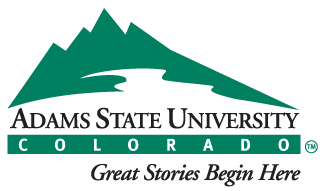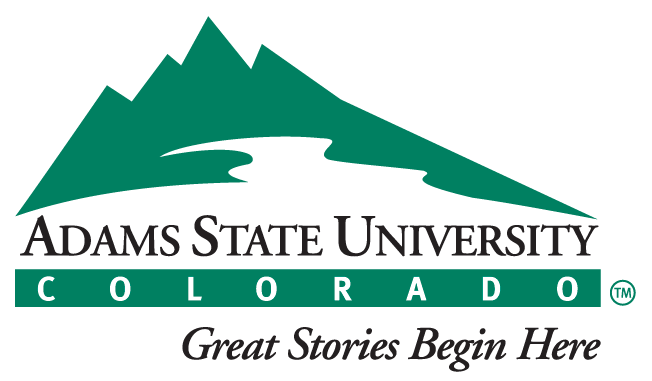Creating art on an interior surface can be dated back to the Lascaux Cave Paintings in France, over 30 thousand years ago. The idea of including expressions of life and art within a structure can be seen in nearly every culture across the centuries. Adams State University Richardson Hall stands among the landmarks to have its walls decorated with regional images, from Native American scenes to more contemporary agricultural depictions.
The final Richardson Hall renovation includes the repair and restoration of the four stairway murals. Randy Pijoan, assisted by Madeleine "Maddie" Ahlborn, began working on the paintings in November and he believes the restoration will be complete by February.
According to Pijoan, nationally recognized artist and Adams State adjunct painting professor, the two south murals were in "epic" disrepair. He said first they prepped the surface including cleaning, scraping and repairing damaged holes in the plaster. "The first month we were assessing and researching the murals for clues as to what materials the original artist used. The second month was spent repairing just two murals in the southern most staircase, which had many issues including chipping, peeling, and cracks."
On one of the murals in the northwest staircase, Pijoan believes there might have been a fire due to the amount of smoke and soot on the surface. "I turned many clean, white rags black wiping off the mural. By the time I finished the bucket and my hands smelled of ashes."
Ahlborn, an Adams State graduate art student agrees, "I have used a lot of muscle with a toothbrush cleaning and prepping the murals."
After cleaning and patching, Pijoan said he uses a polyacrylic product to reseal the images. "In a hundred years, if an improved technique is available for restoration everything we have done can be examined by our notes on file in the museum, so any of our products can be removed or repaired properly." The varnish will also hold off possible water damage in the future. Now, with the murals in their "cleanest" state, Pijoan begins applying paint to areas where chips have removed the original coat. He first matches the value of the paint using a grayscale, white to black. This is a technique he learned when he studied painting in Italy.
He points out areas of the paintings where others have patched the artwork. Even if the color of the paint matched the original, the repair work is obvious. Pijoan said by first painting the areas in grayscale, matching value, this is avoided. "Once the value is matched, we will go back in with color."
Another challenge includes mimicking the quality and type of paint and technique used by the original artist of each mural. "I feel I enter a Zen-like state getting into the head and heart space of the artist."
Ahlborn appreciates learning mural restoration from Pijoan. "A lot goes into it. I have to switch my mind-set, almost time travel to get into the same mind-set of the original artist," Ahlborn said.
Pijoan remembers an art school assignment where students copied a master’s painting. "Recreating a painting you learn all about their technique and brush-stroke choices. Your ego falls away." This introspection leads him to consider the existing murals as perhaps the only ones these artists ever created. "I pay homage to these artists by restoring their art."
Ahlborn absorbs this same attitude. "These murals might be the only surviving pieces by these artists." She and Pijoan appreciate the comments from Richardson Hall employees as they bring about significant improvements. "People are excited to see them improve," Ahlborn added.
People’s reaction to art inspires Pijoan. "Art triggers emotions. It is one of the better parts of the human experience." He believes that "more than money" a happy patron, or customer, fulfills his expectations. "At the end of each day, and each new phase, the murals become more and more like a fresh painting. This, and the reaction of those who witness the transformations, is its own reward."
Perhaps the most significant Richardson Hall mural depicts the legend of the naming of the Sangre de Cristo Mountain Range, located inside the Luther Bean Museum above the entrance. The mural, painted by J. Noel Tucker in 1937, remains in good condition. When first examining all the building’s murals, Pijoan became animated discovering the museum mural’s artist. He has a history with Tucker. Growing up, in the Conifer/Bailey area of Colorado, he attended the same church as Tucker. They formed a connection through their mutual interest in art.
"We would discuss art in general and I was always interested in hearing about Noel’s experience working for Walt Disney," Pijoan said. As near as Pijoan can recall, Tucker worked for Disney after leaving Adams State and before joining the military during WWII. "Noel said Disney was a slave driver."
When Tucker died, his widow donated his art supplies to a then 19-year-old Pijoan. He received an easel, canvas, and stretcher bars – just in time to prepare for his graduate show. "I did not have two pennies to rub together. Inheriting those supplies allowed me to work on the largest canvases I had ever done. I still work large."
Whether restoring the work of a fellow artist or imagining and creating art of his own design, the process fulfills Pijoan. "At the end of the day, it is exciting to know I have created something in the world that was not there prior."


